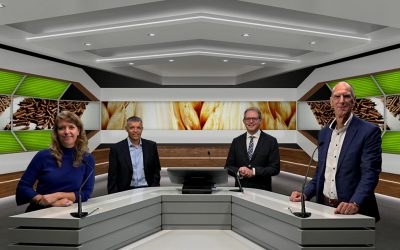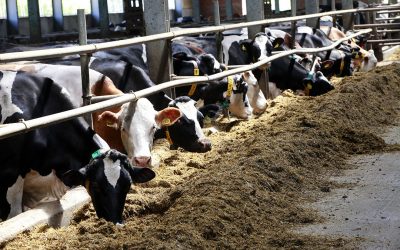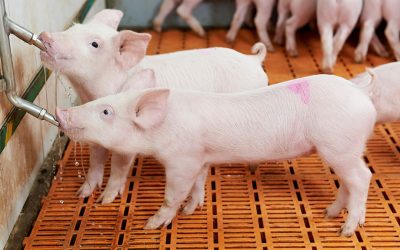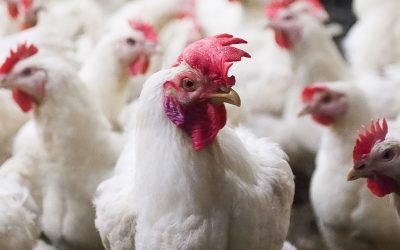Hydrothermal treatment upgrades cereal carriers
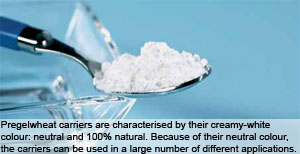
Cereal-based organic carriers are offered in a wide range. One special group is the hydrothermally treated carriers. The hydrothermal treatment to which these carriers are exposed gives them specific characteristics that enhance their functionality.
Carriers are substances that can be used for a variety of purposes. For homogenously mixing micro-components in an end product, for diluting components, as an adhesive medium for components and to enhance free-flowing properties. Depending on the purpose for which the carrier is to be used, a coarse or less coarse carrier will be needed. Besides granulation, a number of other important factors influence the choice of carrier. These include: microbiology, porosity between the particles, free-flowing properties, bulk and tapped weight in relation to separation, moisture and fat absorption, moisture content and colour. When using a carrier to dilute an active substance, the particle size of the carrier must be the same as that of the active ingredients for good mixability and dilution. However, for adhesion purposes, the carrier particles must be bigger than those of the active substance. In all cases the particle size must remain within a small bandwidth to avoid segregation or separation. The hydrothermally treated carriers of Meneba, the Netherlands come in a variety of granulations, enabling to select the right size for the application.
Microbiology and moisture content
The hydrothermal treatment the Pregelwheat carriers have undergone significantly reduces the microbiological values and growth of bacteria, moulds and yeasts. This benefits the shelf life of the end products and enables these carriers to be used in higher-risk applications such as carriers for vitamins for pigs or calf feed (vulnerable groups). An additional advantage of organic carriers is that, unlike their non-organic equivalents, they are 100% natural products. Hydrothermal treatment also controls the moisture content of the Pregelwheat carrier. Moisture contents tend to be around 10% as standard, but additional treatments such as drying are possible. This can reduce the moisture content to 6%, which helps prevent rot, clumping, breakdown of vitamins and reactions of various additives.
Porosity between the particles
Porosity between the particles is linked to the ability to mix with the active substance: more porosity between the particles means better mixing ability. The coarser the hydrothermally treated carrier is, the more porosity between the particles.
Free-flowing properties
Free-flowing properties can be characterised with two parameters: flowability and floodability, which are defined and described in accordance with the Carr method.Free-flowing properties are very important when it comes to the choice of carrier: Bridging during storage, transport and dosing must be avoided. The carrier must flow controllably. Dusting behaviour caused by excessive floodability can pose a risk for people working with carriers. Excessive floodability can result in separation and contamination. Flowability is defined by various product properties: Size of the particles, area of the activity, uniformity, smooth or rough surface, electrostatic character, hygroscopic character and density. The flowability index can be measured on the basis of the above parameters in accordance with the Carr method and is represented in a 7 point scale (Table 1). When, for example, the flowability of the hydrothermal carriers with a granulation of 160-500 μm and 600-1200 μm are determined in this way, they produce an index of 87%, representing good flowability. Similar to flowability, various product properties affect floodability: Surface of the particles, absorption of air, shape of the particles: round, more uniform particles are more floodable, size of the particles, agglomeration, density, hygroscopic character and porosity. The floodability index can be measured on the basis of the above parameters in accordance with the Carr method and is represented in a 5 point scale (Table 2). A high index is undesirable because of the risk of dust formation, for example; a low index is also undesirable because the product will flow very badly, if at all. When, e.g. the floodability of a hydrothermal carrier with a granulation of 160-500 μm and 600-1200 μm are determined in this way, they produce an index of 47% and 69% respectively, representing good floodability.
Bulk and tapped weight in relationto separation
Differences in bulk weight are one of the main causes of separation. The bulk weights of the carrier and the micro-ingredients need to be similar in order to obtain a homogenous mix. The bulk weight must also be close to the tapped weight in order to prevent bridging. To obtain a rapid indication of the free-flowing properties (more quickly than the Carr method), the rule of thumb concerning the difference between the bulk weight and tapped weight can be applied: the smaller the difference, the better the free-flowing properties.
Moisture and fat absorption
The absorbent properties of the carrier are also important when it is used to carry liquid additives. The hydrothermally treated Pregelwheat range absorbs both moisture and oil, and is suitable for this application up to a maximum absorption of approx. 20% – 40%, depending on the granulation. The hydrothermal treatment breaks down the crystal structure of the starch under the influence of moisture, temperature and pressure. This creates a spongy structure that contains a lot of capillaries and is highly absorbent. Depending on the application, dough formation either is or is not permissible when the carrier absorbs moisture or fat. If dough formation is permissible, the sponge effect is more important than the free-flowing properties. If it is not permissible, the carrier must remain free-flowing when carrying the liquid additive. In order to characterise the moisture and oil absorption, Meneba has developed its own methods which are able to predict the behaviour of the carrier in both situations when moisture or oil is applied to it. When the hydrothermal treated carriers are being compared with other organic or inorganic carriers used in practice, it is shown that the thermal treatment improves the water absorbant capacity of Pregelwheat. The fat absorption shows percentages that are similar or better than often used organic and inorganic carriers. The advantages of the thermally treated Pregelwheat however are the better free flowing characteristics.
Conclusion
Pregelwheat carriers are determined by their specific cream white colour. They are neutral and 100% natural. Because of their neutral colour they can be used in a variety of applications. The variety of granulations increases the number of areas in which they can be used. Some of the main advantages of hydrothermally treated carriers are: good microbiological properties, good adhesive properties, free-flowing properties and good moisture and fat absorption properties.




